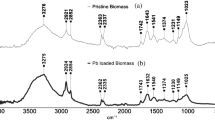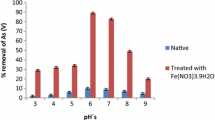Abstract
The lead (II) biosorption potential of Aspergillus parasiticus fungal biomass has been investigated in a batch system. The initial pH, biosorbent dosage, contact time, initial metal ion concentrations and temperature were studied to optimize the biosorption conditions. The maximum lead (II) biosorption capacity of the fungal biosorbent was found as 4.02 × 10−4 mol g−1 at pH 5.0 and 20°C. The biosorption equilibrium was reached in 70 min. Equilibrium biosorption data were followed by the Langmuir, Freundlich and Dubinin-Radushkevich (D-R) isotherm models. In regeneration experiments, no significant loss of sorption performance was observed during four biosorption-desorption cycles. The interactions between lead (II) ions and biosorbent were also examined by FTIR and EDAX analysis. The results revealed that biosorption process could be described by ion exchange as dominant mechanism as well as complexation for this biosorbent. The ion exchange mechanism was confirmed by E value obtained from D-R isotherm model as well.
Similar content being viewed by others
References
An, H. K., Park, B. Y. and Kim, D. S. (2001) Water Res. 35, 3551–3556.
Mishra, K. P., Singh, V. K., Rani, R., et al. (2003) Toxicology 188, 251–259.
Gupta, V. K. and Ali, I. (2004) J. Colloid Interface Sci. 271, 321–328.
Ikeda, M., Zhang, Z. W., Shimbo, S., et al. (2000) Sci. Total Environ. 249, 373–384.
Tewari, N., Vasudevan, P., and Guha, B.K. (2005) Biochem. Eng. J. 23, 185–192.
Iqbal, M. and Edyvean, R. G. J. (2004) Miner. Eng. 17, 217–223.
Khattar, J. I. S., Sarma, T. A., and Singh, D. P. (1999) Enzyme Microb. Technol. 25, 564–568.
Kratochvil, D. and Volesky, B. (1998) Trends Biotechnol. 16, 291–300.
Kratochvil, D. and Volesky, B. (1998) Water Res. 32, 2760–2768.
Vijayaraghavan, K., Jegan, J., Palanivelu, K., and Velan, M. (2004) J. Hazard. Mater. 113, 223–230.
Park, D., Yun, Y. S., and Park, J. M. (2005) Chemosphere 60, 1356–1364.
Goyal, N., Jain, S. C., and Banerjee, U. C. (2003) Adv. Environ. Res. 7, 311–319.
Yan, G. and Viraraghavan, T. (2003) Water Res. 37, 4486–4496.
Akar, T. and Tunali, S. (2006) Bioresour. Technol. 97, 1780–1787.
Akar, T., Tunali, S., and Kiran, I. (2005) Biochem. Eng. J. 25, 227–235.
Kiran, I., Akar, T., and Tunali, S. (2005) Process Biochem. 40, 3550–3558.
Hawari, A. H. and Mulligan, C. N. (2006) Process. Biochem. 41, 187–198.
Akar, T. and Tunali, S. (2005) Miner. Eng. 18, 1099–1109.
Tunali, S., Çabuk, A., and Akar, T. (2006) Chem. Eng. J. 115, 203–211.
Kapoor, A., Viraraghavan, T., and Cullimore, D.R. (1999) Bioresour. Technol. 70, 95–104.
Deng, S. and Ting, Y. P. (2005) Water Res. 39, 2167–2177.
Ozdemir, G., Ozturk, T., Ceyhan, N., Isler, R., and Cosar, T. (2003) Bioresour. Technol. 90, 71–74.
Saeed, A., Iqbal, M., and Akhtar, M. W. (2005) J. Hazard. Mater. 117, 65–73.
Tunali, S. and Akar, T. (2006) J. Hazard. Mater. 131, 137–145.
Bai, S. R. and Abraham, T. E. (2001) Bioresour. Technol. 79, 73–81.
Tangaromsuk, J., Pokethitiyook, P., Kruatrachue, M., and Upatham, E. S. (2002) Bioresour. Technol. 85, 103–105.
Tunali, S., Akar, T., Özcan, A. S., Kiran, I., and Özcan, A. (2006) Sep. Purif. Technol. 47, 105–112.
Gong, R., Ding, Y., Liu, H., Chen, Q., and Liu, Z. (2005) Chemosphere 58, 125–130.
Waranusantigul, P., Pokethitiyook, P., Kruatrachue, M., and Upatham, E. S. (2003) Environ. Pollut. 125, 385–392.
Saeed, A., Akhter, M. W., and Iqbal, M. (2005) Sep. Purif. Technol. 45, 25–31.
Costa, A. C. A. D. and Leite, S. G. F. (1991) Biotechnol. Lett. 13, 559–562.
Öztürk, A., Artan, T., and Ayar, A. (2004) Colloids Surf. B 34, 105–111.
Singh, K. K., Talat, M., and Hasan, S. H. (2006) Bioresour. Technol. 97, 2124–2130.
Pandey, K. K., Prasad, G., and Singh, V. N. (1986) Water Air Soil Pollut. 27, 287–296.
Li, Q., Wu, S., Liu, G., et al. (2004) Sep. Purif. Technol. 34, 135–142.
Kaduková, J. and Virčková, E. (2005) Environ. Int. 31, 227–232.
Langmuir, I. (1918) J. Amer. Chem. Soc. 40, 1361–1403.
Weber, T. W. and Chakravorti, R. K. (1974) J. Amer. Inst. Chem. Eng. 20, 228–238.
Freundlich, H. M. F. (1906) Z. Phys. Chem. 57, 385–470.
Benhammou, A., Yaacoubi, A., Nibou, L., and Tanouti, B. (2005) J. Coll. Interface. Sci. 282, 320–326.
Dubinin, M. M. and Radushkevich, L. V. (1947) Proc. Acad. Sci. USSR Phys. Chem. Sect. 55, 331–333.
Hobson, J. P. (1969) J. Phys. Chem. 73, 2720–2727.
Hasany, S. M. and Chaudhary, M. H. (1996) Appl. Radiat. Isot. 47, 467–471.
Dubey, S. S. and Gupta, R. K. (2005) Sep. Purif. Technol. 41, 21–28.
Hall, K. R., Eagleton, L. C., Acrivos, A., and Vermeulen, T. (1966) Ind. Eng. Chem. Fundam. 5, 212–223.
Gadd, G. M. and White, C. (1985) J. Gen. Microbiol. 131, 1875–1879.
Kuyucak, N. and Volesky, B. (1989) Biotechnol. Bioeng. 33, 823–831.
Pethkar, A. V., Kulkarni, S. K., and Paknikar, K. M. (2001) Bioresour. Technol. 80, 211–215.
Santhiya, D., Subramanian, S., and Natarajan, K. A. (2001) J. Coll. Interface. Sci. 235, 298–309.
Author information
Authors and Affiliations
Corresponding author
Rights and permissions
About this article
Cite this article
Akar, T., Tunali, S. & Çabuk, A. Study on the characterization of lead (II) biosorption by fungus Aspergillus parasiticus . Appl Biochem Biotechnol 136, 389–405 (2007). https://doi.org/10.1007/s12010-007-9032-8
Received:
Accepted:
Issue Date:
DOI: https://doi.org/10.1007/s12010-007-9032-8




